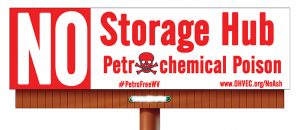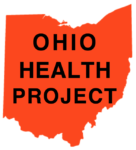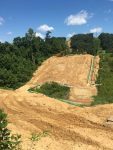For Immediate Release April 9, 2019
Contacts:
Dustin White, OVEC-Ohio Valley Environmental Coalition, 304-541-3144, dustin@ohvec.org;
Deb Smit, Breathe Project, 412-760-7677
What is the Future of Central Appalachia?
Groups Gather for People Over Petrochem Protest and Press Conference
Event Counters Conference Hosted by WV Manufacturers Association
MORGANTOWN, W.Va.—Today more than 40 people representing more than a dozen grassroots groups from West Virginia, Ohio, and Pennsylvania gathered to show their opposition to the Appalachian Storage and Trading Hub, a petrochemical mega-complex build-out proposed for the Ohio and Kanawha river valleys.
The group gathered outside the Marriott at Waterfront Place as the West Virginia Manufacturers Association was hosting the Marcellus and Manufacturing Development Conference, where the Hub was to be a main topic.
Among those gathered was Melcroft, Pa., resident Ashley Funk, a community organizer for Mountain Watershed Association, who said, “We are standing together to show the shale gas and petrochemical industries that, unlike the plastics from which they want to profit, our communities are not disposable.”
The end products of the Hub would be plastics, and its feedstock would come from an increase in regional fracking, which is already wreaking havoc in some north-central West Virginia counties. The infrastructure related to the Hub would stretch along more than 400 miles of the Ohio and Kanawha rivers, and reach into 50 counties in West Virginia, Ohio, Pennsylvania, and Kentucky. It would include underground storage caverns for volatile natural gas liquids, six major pipelines (new pipelines in the region have already exploded*, resulting in destroyed buildings including a home, property damage, livestock deaths and evacuations), thousands of miles of feeder pipelines, and huge polluting factories including fractionators and cracker plants, like the one being built in Beaver County, Pa.**
“It is of upmost importance that people see these current and proposed petrochemical projects in Appalachia for what they are: a scheme that the oil and gas companies are using to bail themselves out of debt. Appalachia has been exploited enough. Every stage of the life-cycle of plastic is toxic and harmful to human health and the environment—from the extraction of the natural gas liquids to the manufacture and use of the products, to the disposal of them. The tide needs to shift to alternatives to plastic, rather than creating more,” said Bridgeport, Ohio, resident, Bev Reed, who attended today’s event. She lives near the site of one component of the Hub, the planned PTTG ethane cracker plant.
Participants in the protest worried about the human health aspects of the Hub. They spoke about the warnings they are receiving from their allies who live in petrochemical regions of Louisiana and Texas known as “Cancer Alley,” and cited the recent petrochemical fires near Houston as reason enough to question the proposed Hub. They talked about Bayou Corne sinkhole, an ongoing incident in Assumption Parish, La., where residents who had been living near a collapsing storage cavern operated by Texas Brine Company and owned by Occidental Petroleum have been evacuated.
Due to the direct human health impacts and the potential for deadly and costly disasters, participants in today’s protest questioned the wisdom of government loans and tax breaks aimed at facilitating the construction of components of the Hub. Given the likelihood of a dramatic increase in regional greenhouse gas emissions from Hub-related infrastructure, participants also questioned the sanity of the Hub.
“It’s nuts for our state to bow down to another round of abuse from fossil fuel corporations,” said Dustin White, project coordinator with OVEC, the Ohio Valley Environmental Coalition, which is based in Huntington, W.Va. “We deserve a diverse and sustainable, community-led economy that is not dependent on fossil fuels with all the associated health and safety risks. Workers deserve better than more toxic jobs.
“The ASH scheme is an unimaginative regression to 1950s era economic development. Why can’t we have real innovation? Development focused on tourism and cottage industries could allow our area to be part of real progress, toward a world we’d want our grandchildren to live in,” White added.
“West Virginia is commonly referred to as ‘almost heaven’ and I could not think of a better way to describe it myself. The places and people here are what makes West Virginia like no other, and for far too long large corporations have plundered our beautiful land and harmed its people,” said Abby Minihan with WVU Sierra Student Coalition. Another coalition member, Ethan Cade, added, “As a young West Virginian, I can say that we are tired of dealing with the negative economic, environmental, and health consequences of corporate pollution and are coming out to fight for a cleaner, better West Virginia.”
“Our oceans are drowning in plastic waste. According to the Monterey Bay Aquarium, up to 1 million seabirds and 100,000 marine mammals and sea turtles die each year from eating our plastic garbage,” said Brenda Jo McManama, a campaign organizer with the Indigenous Environmental Network. “Recycling has become a convenient myth as facilities shut down across the U.S., and other countries close their ports to our garbage. We are literally burying our future in discarded plastic. We are here to demand: No more plastics, no more petro over people! Greed and hubris is destroying any hope of a healthy and safe future for the generations to come.”
Groups involved in the planning of this event include OVEC-the Ohio Valley Environmental Coalition, Concerned Ohio River Residents, Indigenous Environmental Network, Sierra Club WV, Sierra Club OH, Center for Coalfield Justice, Breathe Project, Mountain Watershed Association, and Climate Reality Project: Pittsburgh.
*For April 2, 2019 aerial photos of the site of September 10, 2019 Center Township, Pa., pipeline explosion, see https://drive.google.com/open?id=1UpT_g6Oe5MqW18PV8wHsO5M7juU1iV8l
**For April 2, 2019 aerial photos of the Beaver County, Pa. Shell cracker plant construction site on the Ohio River, see https://drive.google.com/open?id=1QixGLvi8eVuCptDDs_JWprfttVMWK27H
To publish any of these photos, please credit: Ted Auch, PhD, Great Lakes Program Coordinator, FracTracker Alliance; flyover courtesy LightHawk.
###






